
 Production Reference:
Production Reference:|
|
Translator's Note: Published in April 1991 as part of Kodansha's "TV Magazine Special Collection" series, Mobile Suit Gundam Great Complete Works was a one-volume retrospective of the first ten years of the Gundam series. As well as information on the story, characters, and mobile suits, it included in-depth features on the production background and exclusive interviews with some of the major creators. I've translated these interviews below. The following text is copyright © 1991 Sotsu • Sunrise. |
Director of many TV anime. Original creator and chief director of Gundam series. |
—First, please tell us about the planning of the original Gundam.The genesis of the project was that I wanted to use a giant robot show to lie to the sponsors. After the hundred-meter Daitarn 3, the 18-meter Gundam wasn't really a giant robot, but it definitely produced the feeling of a giant robot onscreen, and so they accepted it. At that point, the initial idea of Gundam was to put the backdrop of a war behind a giant robot show so we could make it a somewhat serious work. We set the story in space because the stage would become narrower if it took place on Earth, and we wouldn't have been able to create the situation of the current Gundam with its other big themes. |
In a giant robot show, it's destined that the main character will have to pilot the robot from the first episode. Because the military is taboo in Japanese TV anime, the main character can't be a soldier. I knew as early as the first episode that it would be impossible for an ordinary civilian boy to pilot the Gundam unless he had some special ability. But I didn't want to simply make the boy a psychic. Psychics were already entrenched as a standard science fiction genre, and around the time of broadcast there were also movies like ESPY (a Toho production), so I wanted to avoid that.
Thus, when we were doing the first cours, I wondered whether some exceptional ability other than psychic powers might enable him to pilot the robot. In episode 9, Matilda says of Amuro that "you may be some kind of esper." At that point, I hadn't yet managed to come up with the term "Newtype." But since I'd decided not to make him an esper, I was confident that was fine. Don't humans have the potential to develop their abilities even further? And when they have that power, they could become another kind of human with a higher average... Thinking along those lines, I ultimately created the Newtype term. I recall that was in the middle of the second cours.
I had a certain amount of confidence in its quality as a work. But since it was never just a fighting robot show, I felt nothing but external pressure, especially in terms of audience reaction. After all, we were showing them something they'd never seen before... It wasn't a work that I could put forward with unshakeable confidence.
The people at the TV stations and advertising agencies also recognized the craftsmanship of the work, but as a giant robot show, it seems they didn't think it was a very good product advertisement. I felt the same way, too. And in fact, the ratings didn't grow, and the series was... So that judgement must have been correct.
Left: During planning, the Gundam's colors were entirely white, but other colors were added at the request of the sponsors. Is this the reason it's called "white mobile suit" in the story?
Right: Due to his chance encounter with Lalah, Amuro awakens as a Newtype. However, he and the other Newtypes who follow him retreat in the face of reality.
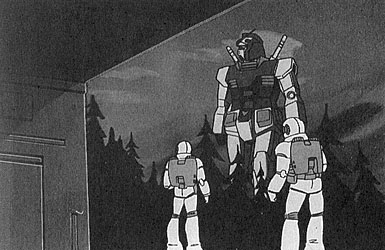
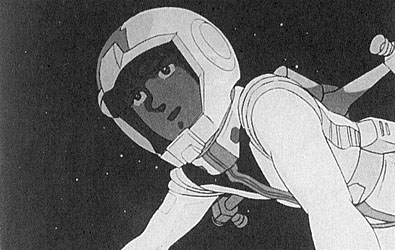
They approached me about one year before it was on the air. But given the trends, I realized about three years earlier that we'd have to make another Gundam. Since the toymakers had fleshed out Gundam and developed the market to such an extent, there was no way we couldn't.
If we'd joined in that field, it would have killed off the business. In order to expand the business, you have to offer different directions. The things the toymakers created were simply adding detail to Gundam. I felt that if we made something that merely added those details, in the TV medium that should be a source of original information, then the followup Z Gundam would automatically be an anticlimax. I prefer to do as I please, so I'd never do that. That kind of field already existed, and the market was considerably expanded. The only way I could add extra value to that was to express myself as an individual.
If I created an independent story that had points of contact with Gundam, rather than just expanding or extending it, then the new parts would yield added value. And that's how Z Gundam became like that.
They're actually deemphasized. If the Newtype theory got more and more prominent, then their abilities would become ESP and we'd end up in an SF world. I didn't want that, so I deemphasized the themes instead. That's why Kamille, the main character of Z Gundam, is a sick person. Basically, to me, Kamille is sick in an extremely minor way. Though he has some attributes that are momentarily prominent, when you look at his whole character, he has quite a disordered personality. (1)
Why did I do that? If the main character is at a higher level than us, then even if they're an esper we're not supposed to understand, the audience won't be able to empathize with them whether they live or die. It's generally easier to understand if if they're looking up at ordinary people from a field one step behind them.
Also, in the years after the completion of the Gundam movie trilogy, when I observed the behavior of children I had the impression, "Oh, a lot of them are sick now." So I made the main character Kamille someone that modern children could relate to, with the thought, "You guys hang in there, too!"
Left: From the storyboards of the third movie. Amuro and Lalah resonate.
Center: With Chieko Baisho during the postrecording of the first movie.
Right: Ever since the original Gundam, Director Tomino has written novelizations of the entire series (and the original plan in the case of ZZ).
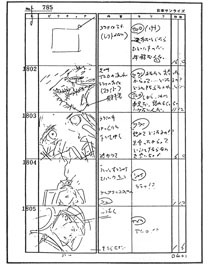
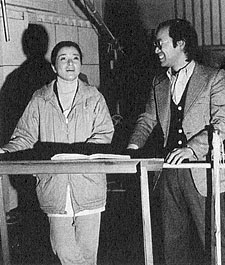
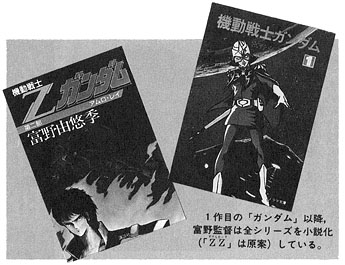
After all, we couldn't be pulled in by the weight of Z Gundam for two years, so naturally I was planning a change of course. (2) And from a business standpoint, the toy-friendly attributes that are intrinsic to giant robot shows also had to be added to the work. That's why we made it a combining robot show. I also wanted to use Gundam to teach the young staff how to make the kind of humorous works that had vanished for a while.
In the end, the work was pulled in by Kamille's sickness. I suppose Kamille had a "weight" beyond that of just a character in the story. We couldn't overcome it even by bringing in Judau.
That's what I'd decided. Because Mr. Yasuhiko wasn't participating, Char and the others were the only way to attract customers.
I simply feel it's a theme that exceeds my own abilities. On the other hand, it's hard enough just being able to set up themes and problems that exceed yourself. In the end, I've been struggling with it internally for ten years. One might say that's not such a bad thing. But at the same time, I'm feeling the limits of my abilities.
(November 11, 1990, in Suginami, Tokyo)
(1) Here, Tomino describes Kamille as 超マイナーな病人 (literally "a super-minor sick person") and かなりの性格破綻者 (either "a person with a rather flawed personality" or "a person with quite a personality disorder," depending on whether you prefer a clinical-sounding interpretation).
(2) The Japanese phrase used here, 引っ張る ("pulled in"), isn't exactly the same term used in Z Gundam to describe the effect of Earth's gravity on human souls. It's close, though.
Supported all the visuals of Gundam as character designer and animation director. |
—How did you become involved in Gundam, Mr. Yasuhiko?I'd previously worked together with Director Tomino on Zambot 3, but at that point I also had other jobs, so I could only do the character design. I had to entrust the characters I made completely to the director. This was about two years later. Since they were doing a new work, they asked whether this time I could take it all the way to animation. |
At first, we began with planning meetings where we laid around discussing this and that. Then an original draft called a "Tomino Memo" was made and circulated. I thought it would be a good story. It was a whole different dimension from the previous pro wrestling-like robot shows. But in fact, it was also a lot of work... (laughs) I still haven't forgotten how we poured all our energy into making the first episode.
It must be Amuro Ray. I'd always wanted to draw a boy with that image. The director and I were in perfect agreement.
Char is a character who combines all the ideal parts of Director Tomino. (laugh) But if I'd known from the beginning that he'd be burdened with such an unhappy destiny, I wouldn't have given him such a manga-like costume. I guess it's completely out of place.
Left: The characters of Gundam were freely designed by Mr. Yasuhiko based on Director Tomino's memo, which included only a simple story and the names of the featured characters. In this process, their personality setting was created afterwards.
Right: The new cuts in the Gundam III movie comprised 70% of the total. Since the majority of the key frames were carefully corrected by Mr. Yasuhiko, the drawing density was far higher than the TV version.
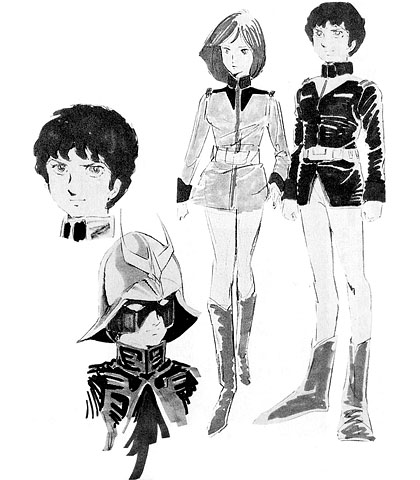
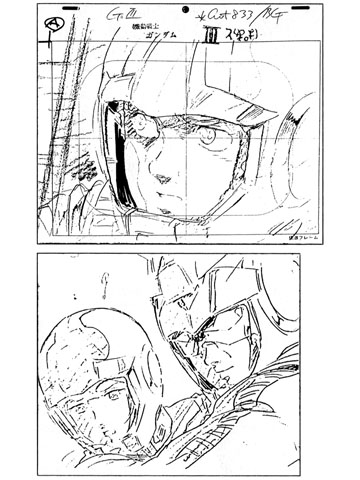
Lalah was really tough, since I couldn't grasp the Newtype concept that Director Tomino was embracing. What's more, I was hospitalized for overwork just as she showed up... When I watched the final episode from my hospital bed, I was truly disappointed. Afterwards, I thought that I'd wanted to draw it to the end with my own hands.
If we hadn't done the movie version after that, I'd probably still be regretting it. Director Tomino also wanted to fix the film after the point where I collapsed, and when we did the movies, it was on the condition that we could correct the animation. We only had a small animation correction team to do it with, but we all worked hard to complete the job.
For that work, I participated on the condition that I'd only be doing the character design. That's because all the characters were extensions of Lalah. (laughs) It was a continual struggle. But I think it's a pity that, aside from Amuro, I didn't understand very well what the characters were like seven years later.
(November 9, 1990, in Tokorozawa, Saitama Prefecture)
Mechanical designer. Drew most of the MS and mecha that appear in Gundam. |
—How do you come to do the mechanical designs for Gundam, Mr. Okawara?I began working with Sunrise right around the time of Daitarn 3. They gave me work as a freelance designer after I resigned as an employee of Tatsunoko Production. My designs at the time were also favorably received by the sponsors, and for some reason I was pulled in by the atmosphere of Gundam, so it was expected that I'd continue on to that. And as for myself, I had a hunch that next time I'd be free to do pretty much as I pleased. |
Yes, we had a kind of tacit agreement. And then, even if it was a robot show, we considered whether we could create the kind of world we wanted to, or make a more ambitious science fiction work. We researched the cutting-edge science of the time to create so-called realistic SF.
To some extent I was able to do as I pleased, but toys were being produced after all, so I could never completely eliminate the smell of a giant robot show. Nonetheless, I thought I should create something with as much awareness as possible of human anatomy.
Left: First draft of the White Base plan. Originally meant to appear in Daitarn 3, this mecha was called the Freedom Fortress.
Right: On the right, the Heavy Artillery Type Mobile Infantry design on which the Guncannon was based (first draft). On the left, the Assault Type Mobile Infantry that was the prototype for the Gundam (second draft). The difference in the image can be seen in these rough drawings.
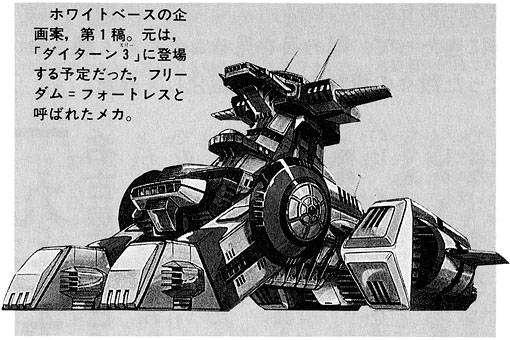
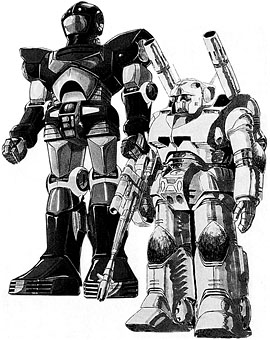
At the time, we didn't think the enemy mecha would be turned into products. So as long as the design set off the starring Gundam to good advantage, anything would do. And I believe Director Tomino's only request was that mono-eye... So I more or less drew it as I pleased. I'm pretty sure I finished it in about one week.
I don't care for so-called scary mecha, so it retains the image of being purely a machine.
To some extent, I did as I pleased up until the Dom. After that, there were a lot of instructions from Director Tomino. He was strongly attached to this work, so I constantly received instructions like, "I want a mobile suit with this sort of image" or "Draw me a mobile suit to suit this kind of story." So all I could do was to digest them in my own style. That said, they were still pretty rough, but... (3)
Well, a lot of people made good money from those works, didn't they? (laughs) But for me, it was a completely playful job, and I really enjoyed drawing them.
However, I do have a slight regret. Since I didn't expect they'd be around all that long, their development was fairly haphazard. I feel I should have drawn them a little more thoughtfully.
(November 8, 1990, in Inagi, Tokyo Metropolis)
(3) I think Okawara is referring here to Tomino's original sketches.
Mobile Suit Gundam is copyright © Sotsu • Sunrise. Everything else on this site, and all original text and pictures, are copyright Mark Simmons.